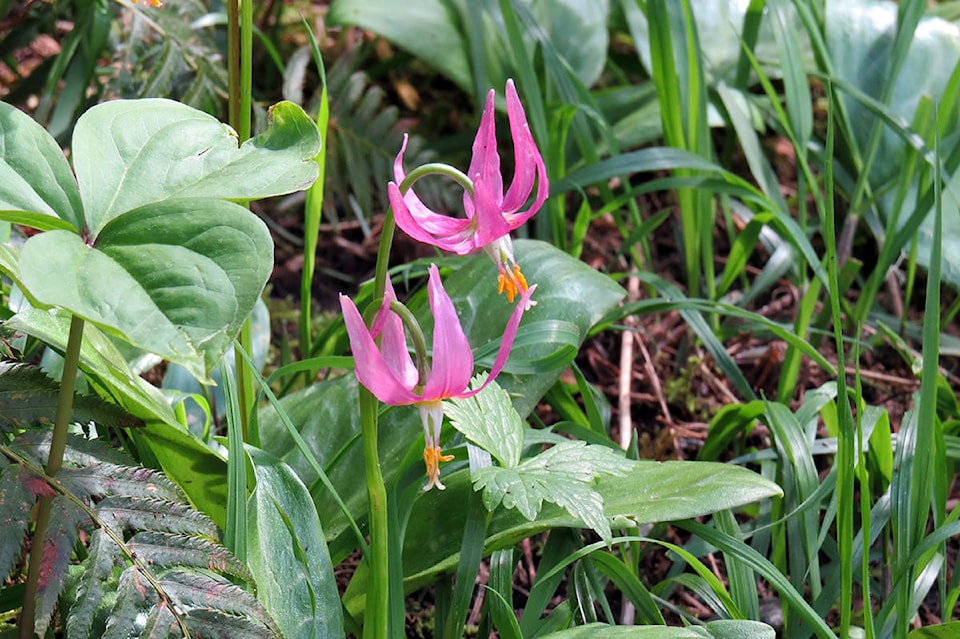Leslie Cox
Special to The Record
Walk through any one of our local parks right now and you will likely see fawn lilies and trilliums in bloom - a beautiful sight indeed.
Fawn lilies, especially, take me back to my childhood and family excursions at Easter to Metchosin, just outside of Victoria. While there, we always visited the historic Anglican church, St. Mary the Virgin, built in 1873. This tiny church is a delight in itself but it was the cemetery that always took my breath away with its vast carpet of Erythronium oregonum (white fawn lilies). A thing of beauty which remains a destination spot for visitors decades later.
So, imagine my delight to see carpets of pink fawn lilies, Erythronium revolutum, in so many parts of the Comox Valley. Such a fitting, spring blooming plant found nestled in pockets under evergreens where the sun reaches them through massive, barren-leaved maples.
Both the white and pink fawn lilies are distinguishable from other Erythronium species by the purplish-brown or white markings on their basal leaves…looking so much like the spots on a young fawn, hence the common name. Both produce a single flower atop a leafless stem.
| A white fawn lily. Photo by Leslie Cox |
These two species can be seen in moist, forested regions of the coastal Pacific Northwest area, stretching from southwest British Columbia to the northwestern part of California.
And where you find fawn lilies you can usually spot the western trillium, Trillium ovatum. This plant stands out for its whorls of three, triangular-shaped leaves that end in a gently bending “drip tip.” And oh my! The flowers! Three pure white petals stretching to two inches in length reposing atop the medium green leaves. Purely majestic in its simple form.
I recommend all forest lovers make repeat visits to view the trilliums, if you do not already, that is. Further beauty unfurls as the flowers age with the pure white morphing into pink through to almost purple.
Of interest, trilliums have a symbiotic relationship with ants, which is very important to its continuity as a species. Each seed has a tiny appendage which is rich in oil. This oil attracts ants who harvest the seeds and carry them back to their nest. The appendages are then fed to the larvae and the remaining seeds are carried out of the nest to the rubbish piles. (Ants are such great housekeepers.)
This is a very effective seed dispersal mechanism for trilliums. Reposing on the forest floor as they do, there is not much wind that reaches them. Therefore, their fresh seeds must be carried away to new planting locations. Nature looking after its own.
Unfortunately, that is not always the case. I am talking about alien species – species which are brought in to our region through global traffic, or through natural migration due to changes in climate.
One such pest is the spotted wing fruit fly, Drosophila suzukii. Its numbers have increased rapidly and can be found in significant pocket areas throughout the Pacific Northwest, including here in the Comox Valley.
Of alarming note was to learn this pest survived the extreme record cold temperatures we had last February.
Everyone who grows soft fruits – raspberries, strawberries, etc. – should be setting out traps to catch these flies. Punch six to eight holes around the rim of a lidded plastic container, fill with an inch of apple cider vinegar, cover with lid and place in the garden. The aim is to eradicate this pest. A daunting task indeed.
While you are on pest control, check the underside of your azalea leaves for tiny sawfly eggs. Remove and bag any such leaves to reduce unsightly larval damage.
And when you have finished, take yourself for a soothing walk through a forest carpeted with fawn lilies. You will feel better.
Leslie Cox co-owns Growing Concern Cottage Garden in Black Creek. Her website is at www.duchessofdirt.ca and her column appears every second Thursday in the Record throughout the spring and summer months.
